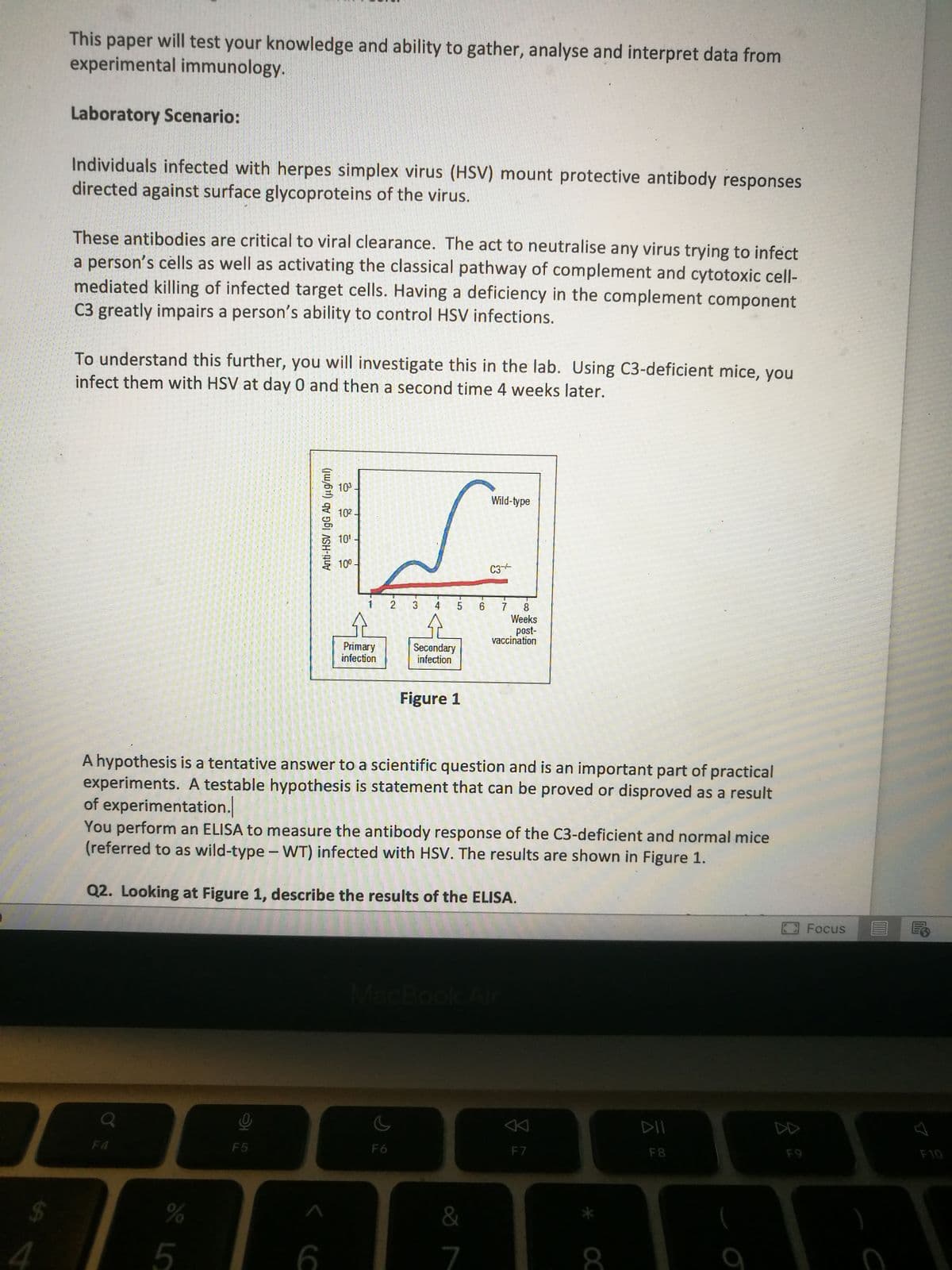Individuals infected with herpes simplex virus (HSV) mount protective antibody responses directed against surface glycoproteins of the virus. These antibodies are critical to viral clearance. The act to neutralise any virus trying to infect a person's cells as well as activating the classical pathway of complement and cytotoxic cell- mediated killing of infected target cells. Having a deficiency in the complement component C3 greatly impairs a person's ability to control HSV infections. To understand this further, you will investigate this in the lab. Using C3-deficient mice, you infect them with HSV at day 0 and then a second time 4 weeks later. Anti-HSV IgG Ab (µg/ml) 10³. 102. 10¹. 10⁰. 1 2 3 4 5 Primary infection Secondary infection Figure 1 6 Wild-type C3 7 8 Weeks post- vaccination A hypothesis is a tentative answer to a scientific question and is an important part of practical experiments. A testable hypothesis is statement that can be proved or disproved as a result of experimentation. You perform an ELISA to measure the antibody response of the C3-deficient and normal mice (referred to as wild-type - WT) infected with HSV. The results are shown in Figure 1. Q2. Looking at Figure 1, describe the results of the ELISA.
Individuals infected with herpes simplex virus (HSV) mount protective antibody responses directed against surface glycoproteins of the virus. These antibodies are critical to viral clearance. The act to neutralise any virus trying to infect a person's cells as well as activating the classical pathway of complement and cytotoxic cell- mediated killing of infected target cells. Having a deficiency in the complement component C3 greatly impairs a person's ability to control HSV infections. To understand this further, you will investigate this in the lab. Using C3-deficient mice, you infect them with HSV at day 0 and then a second time 4 weeks later. Anti-HSV IgG Ab (µg/ml) 10³. 102. 10¹. 10⁰. 1 2 3 4 5 Primary infection Secondary infection Figure 1 6 Wild-type C3 7 8 Weeks post- vaccination A hypothesis is a tentative answer to a scientific question and is an important part of practical experiments. A testable hypothesis is statement that can be proved or disproved as a result of experimentation. You perform an ELISA to measure the antibody response of the C3-deficient and normal mice (referred to as wild-type - WT) infected with HSV. The results are shown in Figure 1. Q2. Looking at Figure 1, describe the results of the ELISA.
Human Heredity: Principles and Issues (MindTap Course List)
11th Edition
ISBN:9781305251052
Author:Michael Cummings
Publisher:Michael Cummings
Chapter17: Genes And The Immune System
Section: Chapter Questions
Problem 31QP
Related questions
Question

Transcribed Image Text:F
4
This paper will test your knowledge and ability to gather, analyse and interpret data from
experimental immunology.
Laboratory Scenario:
Individuals infected with herpes simplex virus (HSV) mount protective antibody responses
directed against surface glycoproteins of the virus.
These antibodies are critical to viral clearance. The act to neutralise any virus trying to infect
a person's cells as well as activating the classical pathway of complement and cytotoxic cell-
mediated killing of infected target cells. Having a deficiency in the complement component
C3 greatly impairs a person's ability to control HSV infections.
To understand this further, you will investigate this in the lab. Using C3-deficient mice, you
infect them with HSV at day 0 and then a second time 4 weeks later.
%
5
D
F5
Anti-HSV IgG Ab (μg/ml)
<C
6
10³.
10².
10¹
10⁰-
1 2 3 4
Primary
infection
5 6
A hypothesis is a tentative answer to a scientific question and is an important part of practical
experiments. A testable hypothesis is statement that can be proved or disproved as a result
of experimentation.
You perform an ELISA to measure the antibody response of the C3-deficient and normal mice
(referred to as wild-type-WT) infected with HSV. The results are shown in Figure 1.
Q2. Looking at Figure 1, describe the results of the ELISA.
F6
Secondary
infection
Figure 1
Wild-type
&
7
C3
T
7
8
Weeks
post-
vaccination
F7
8
DII
F8
P
F9
Focus
Expert Solution
This question has been solved!
Explore an expertly crafted, step-by-step solution for a thorough understanding of key concepts.
Step by step
Solved in 2 steps

Knowledge Booster
Learn more about
Need a deep-dive on the concept behind this application? Look no further. Learn more about this topic, biology and related others by exploring similar questions and additional content below.Recommended textbooks for you

Human Heredity: Principles and Issues (MindTap Co…
Biology
ISBN:
9781305251052
Author:
Michael Cummings
Publisher:
Cengage Learning



Human Heredity: Principles and Issues (MindTap Co…
Biology
ISBN:
9781305251052
Author:
Michael Cummings
Publisher:
Cengage Learning



Human Biology (MindTap Course List)
Biology
ISBN:
9781305112100
Author:
Cecie Starr, Beverly McMillan
Publisher:
Cengage Learning

Anatomy & Physiology
Biology
ISBN:
9781938168130
Author:
Kelly A. Young, James A. Wise, Peter DeSaix, Dean H. Kruse, Brandon Poe, Eddie Johnson, Jody E. Johnson, Oksana Korol, J. Gordon Betts, Mark Womble
Publisher:
OpenStax College

Concepts of Biology
Biology
ISBN:
9781938168116
Author:
Samantha Fowler, Rebecca Roush, James Wise
Publisher:
OpenStax College